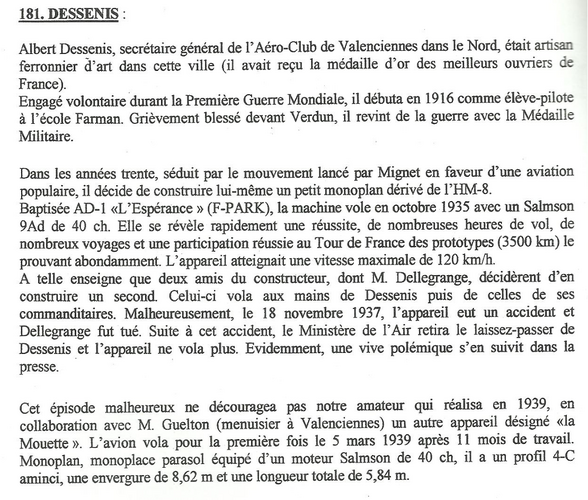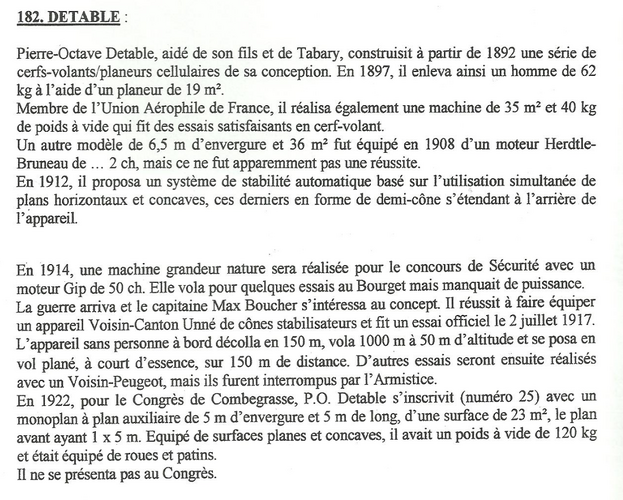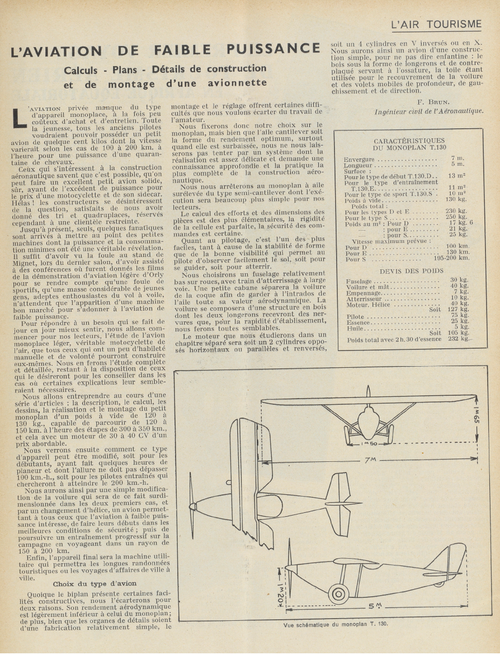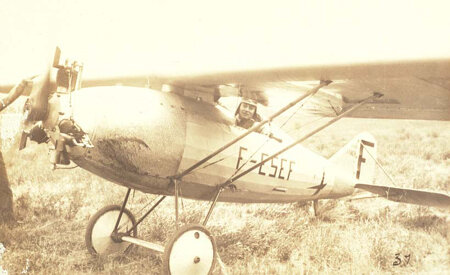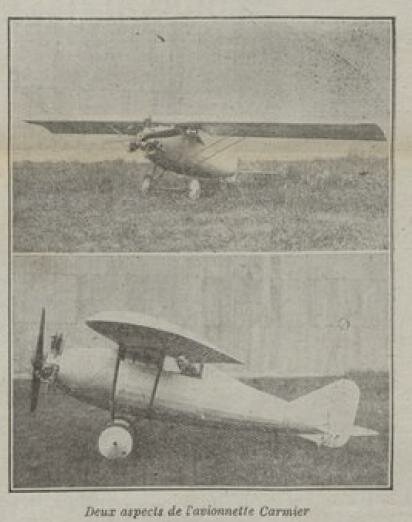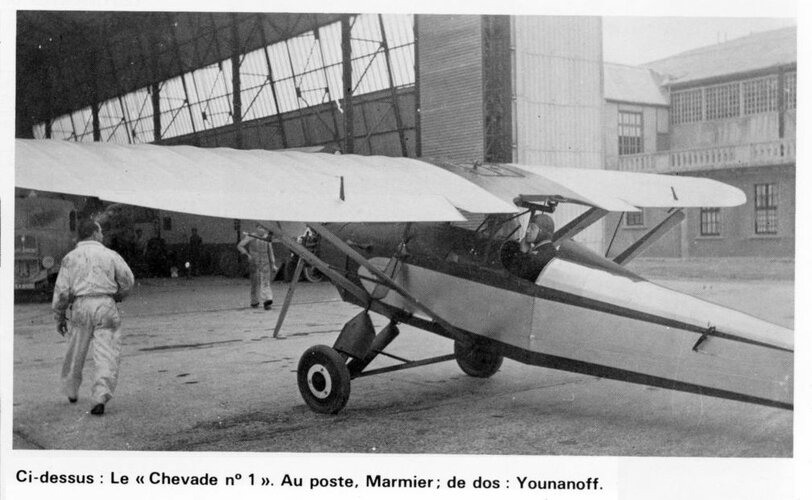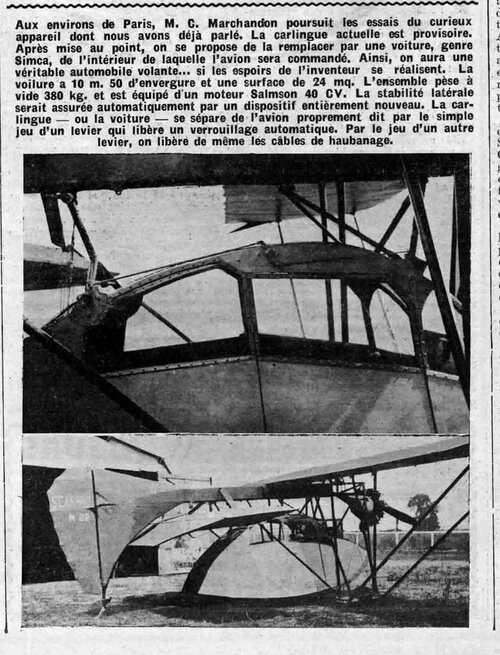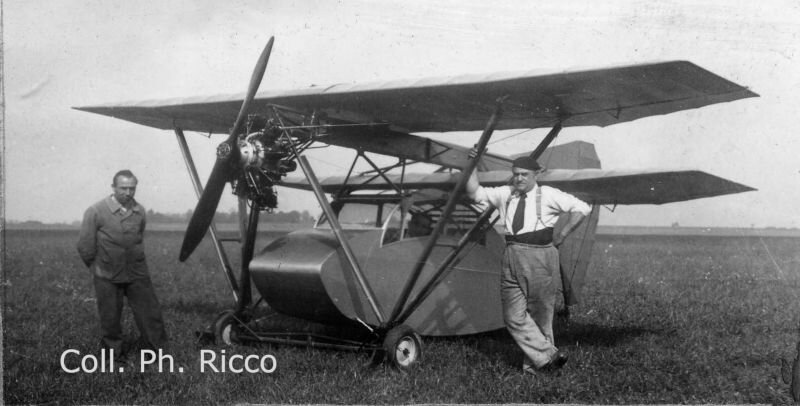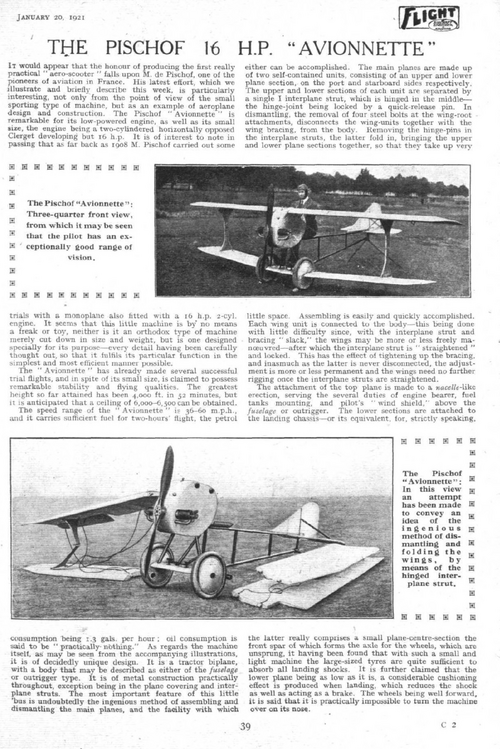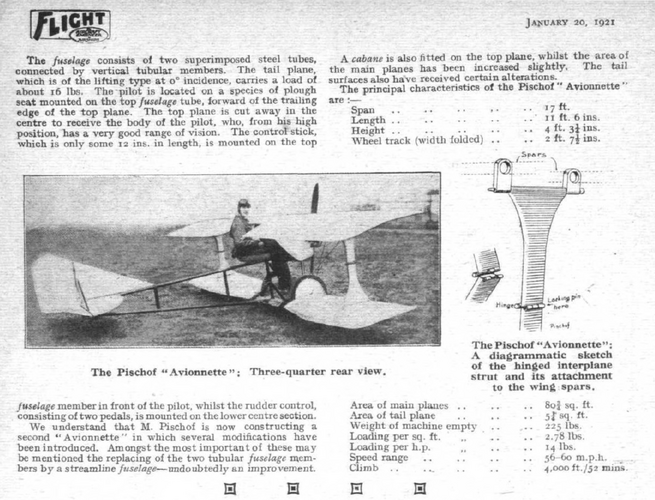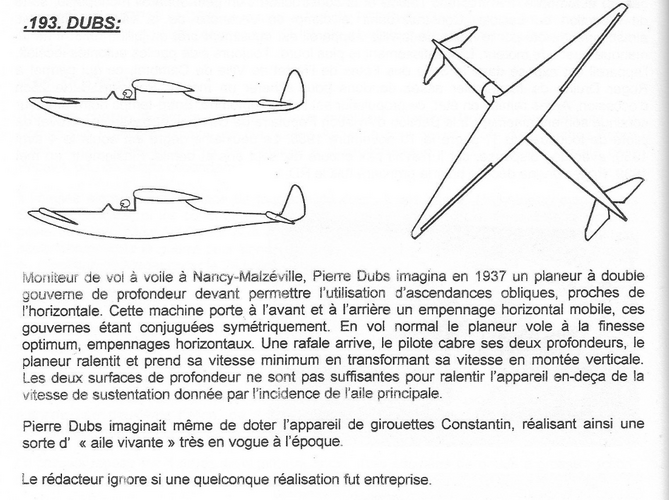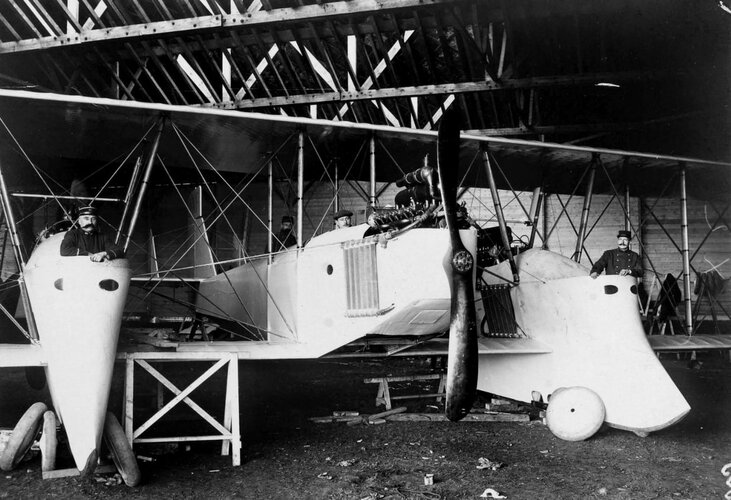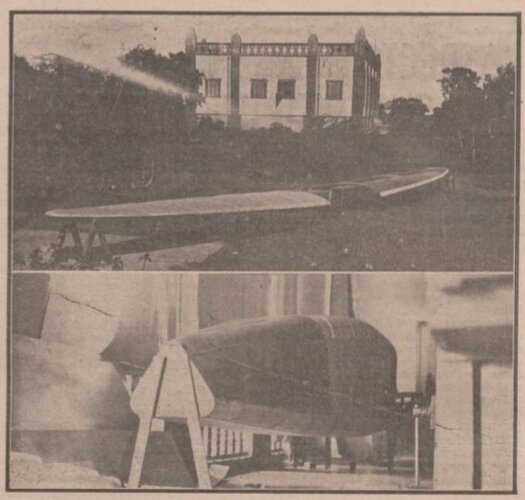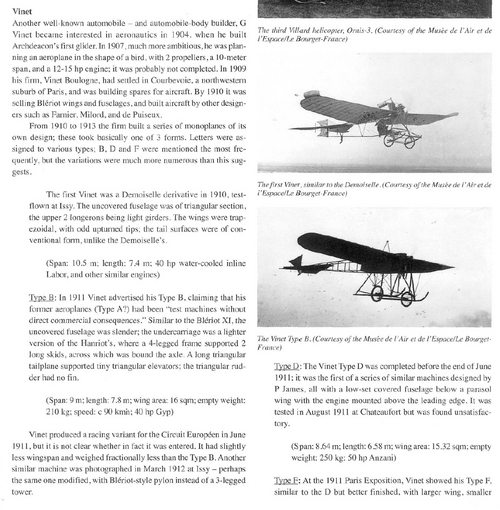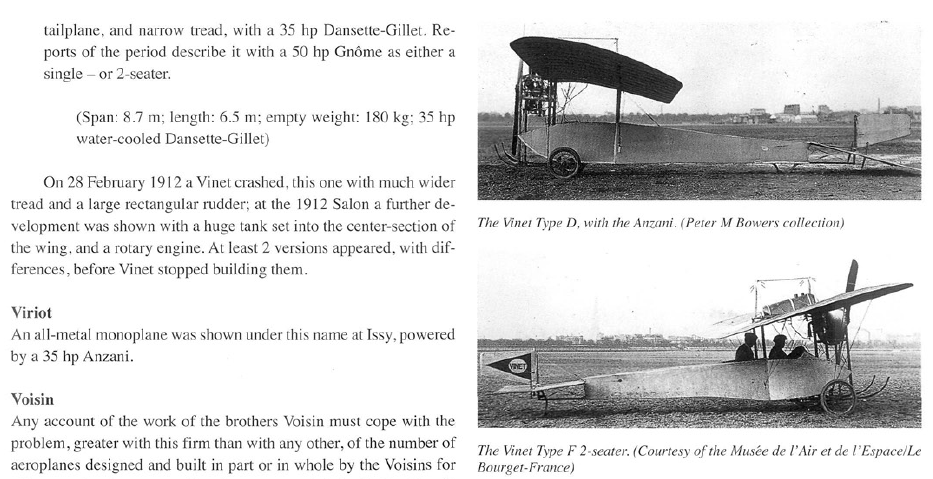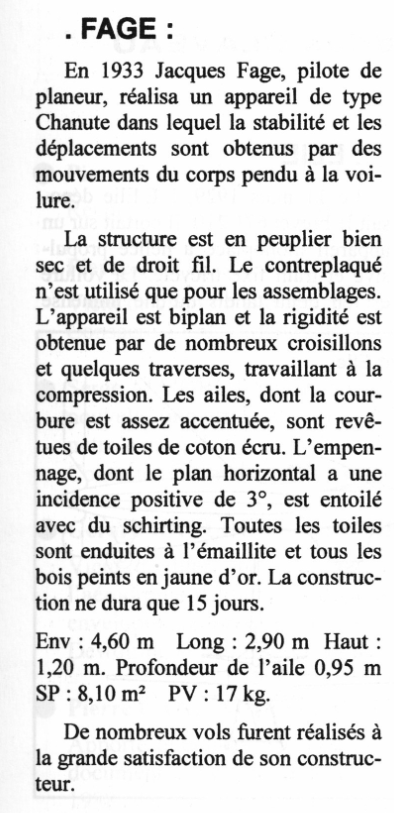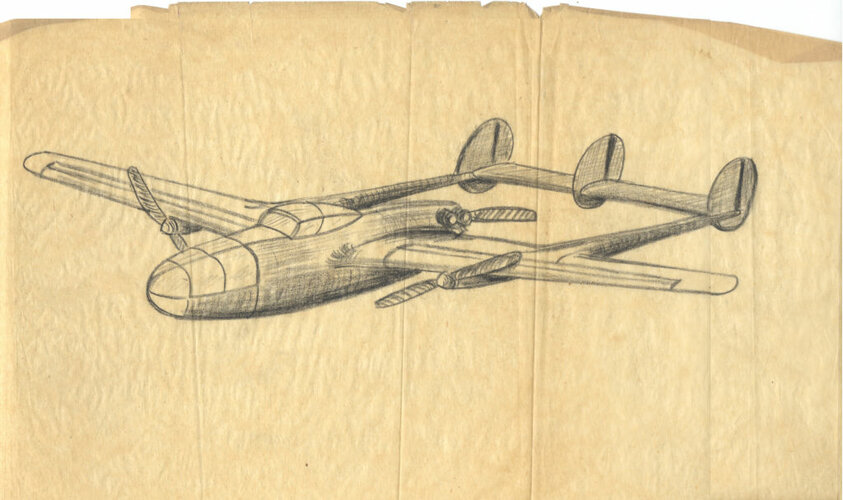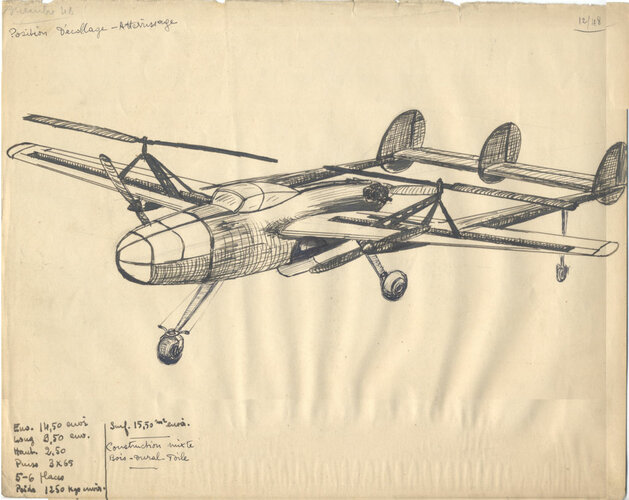You are using an out of date browser. It may not display this or other websites correctly.
You should upgrade or use an alternative browser.
You should upgrade or use an alternative browser.
Little-Known French Projects and Prototypes
- Thread starter hesham
- Start date
- Joined
- 26 May 2006
- Messages
- 34,946
- Reaction score
- 15,838
From TU 187,
DESSENS:
Albert Dessenis, general secretary of the Aero-Club of Valenciennes in the North, was an artistic ironworker in this city (he had received the gold medal for the best workers in France).
Volunteering during the First World War, he started in 1916 as a student pilot at the Farman school. Seriously wounded in front of Verdun, he returned from the war with the Military Medal.
In the 1930s, seduced by the movement launched by Mignet in favor of popular aviation, he decided to build himself a small monoplane derived from the HM-8.
Named AD-1 “L’Espérance” (F-PARK), the machine flew in October 1935 with a 40 hp Salmson 9Ad. It quickly proved to be a success, with many hours of flight, numerous trips and successful participation in the Tour de France of prototypes (3500 km) proving this abundantly. The aircraft reached a maximum speed of 120 km/h.
So much so that two friends of the builder, including Mr. Dellegrange, decided to build a second one. This flew into the hands of Dessenis and then into those of his sponsors. Unfortunately, on November 18, 1937, the aircraft had an accident and
Dellegrange was killed. Following this accident, the Air Ministry withdrew Dessenis' pass and the aircraft no longer flew. Obviously, a lively controversy ensued in the press.
This unfortunate episode did not discourage our amateur who created in 1939, in collaboration with Mr. Guelton (carpenter in Valenciennes), another device called “the Seagull”. The plane flew for the first time on March 5, 1939 after 11 months of work.Monoplane, single-seater parasol equipped with a 40 hp Salmson engine, it has a slimmed down 4-C profile, a wingspan of 8.62 m and a total length of 5.84 m.
DESSENS:
Albert Dessenis, general secretary of the Aero-Club of Valenciennes in the North, was an artistic ironworker in this city (he had received the gold medal for the best workers in France).
Volunteering during the First World War, he started in 1916 as a student pilot at the Farman school. Seriously wounded in front of Verdun, he returned from the war with the Military Medal.
In the 1930s, seduced by the movement launched by Mignet in favor of popular aviation, he decided to build himself a small monoplane derived from the HM-8.
Named AD-1 “L’Espérance” (F-PARK), the machine flew in October 1935 with a 40 hp Salmson 9Ad. It quickly proved to be a success, with many hours of flight, numerous trips and successful participation in the Tour de France of prototypes (3500 km) proving this abundantly. The aircraft reached a maximum speed of 120 km/h.
So much so that two friends of the builder, including Mr. Dellegrange, decided to build a second one. This flew into the hands of Dessenis and then into those of his sponsors. Unfortunately, on November 18, 1937, the aircraft had an accident and
Dellegrange was killed. Following this accident, the Air Ministry withdrew Dessenis' pass and the aircraft no longer flew. Obviously, a lively controversy ensued in the press.
This unfortunate episode did not discourage our amateur who created in 1939, in collaboration with Mr. Guelton (carpenter in Valenciennes), another device called “the Seagull”. The plane flew for the first time on March 5, 1939 after 11 months of work.Monoplane, single-seater parasol equipped with a 40 hp Salmson engine, it has a slimmed down 4-C profile, a wingspan of 8.62 m and a total length of 5.84 m.
Attachments
- Joined
- 25 July 2007
- Messages
- 4,307
- Reaction score
- 4,210
-- https://1000aircraftphotos.com/Contributions/Shumaker/13689.htm
hesham could we prevail upon you to proof and edit Google Translate results, thus avoiding unhelpful renderings? To wit:
DESSENIS:
Albert Dessenis, secretary-general of the Aéro-Club de Valenciennes ... Seriously wounded on the Verdun front, he returned from the war awarded the Médaille militaire...
... including M. Dellegrange ...
... Following this accident, the Ministère de l'Air withdrew Dessenis' permit-to-fly and the aircraft could no longer be flown.
... in collaboration with M. Guelton (a carpenter from Valenciennes), another device called «la Mouette» ['the Seagull'] ...[/U][/U]
hesham could we prevail upon you to proof and edit Google Translate results, thus avoiding unhelpful renderings? To wit:
DESSENIS:
Albert Dessenis, secretary-general of the Aéro-Club de Valenciennes ... Seriously wounded on the Verdun front, he returned from the war awarded the Médaille militaire...
... including M. Dellegrange ...
... Following this accident, the Ministère de l'Air withdrew Dessenis' permit-to-fly and the aircraft could no longer be flown.
... in collaboration with M. Guelton (a carpenter from Valenciennes), another device called «la Mouette» ['the Seagull'] ...[/U][/U]
Last edited:
- Joined
- 26 May 2006
- Messages
- 34,946
- Reaction score
- 15,838
From TU 187,
DETABLE :
Pierre-Octave Detable, helped by his son and Tabary, built from 1892 a series of cellular kites/gliders of his design. In 1897, he kidnapped a 62 kg man using a 19 m glider.
Member of the Union Aérophile de France, he also created a machine of 35 m° and 40 kg of empty weight which carried out satisfactory tests in kite flying.
Another model with a wingspan of 6.5 m and 36 m° was equipped in 1908 with a Herdtle-Bruneau engine of ...
2 ch, but it was apparently not a success.
In 1912, he proposed an automatic stability system based on the simultaneous use of horizontal and concave planes, the latter in the shape of a half-cone extending to the rear of the device.
In 1914, a full-size machine was built for the Safety competition with a 50 hp Gip engine. It flew for a few tests at Le Bourget but lacked power.
The war arrived and Captain Max Boucher became interested in the concept. He succeeded in having a Voisin-Canton Unné aircraft equipped with stabilizing cones and carried out an official test on July 2, 1917.
The aircraft without anyone on board took off in 150 m, flew 1000 m at an altitude of 50 m and landed in a glide, running out of fuel, over a distance of 150 m. Other tests were then carried out with a Voisin-Peugeot, but they were interrupted by the Armistice.
In 1922, for the Combegrasse Congress, P.O. Detable registered (number 25) with a monoplane with an auxiliary plane of 5 m wingspan and 5 m long, with a surface area of 23 m?, the front plane having 1 x 5m. Equipped with flat and concave surfaces, it had an empty weight of 120 kg and was equipped with wheels and skids.
He did not run for Congress.
DETABLE :
Pierre-Octave Detable, helped by his son and Tabary, built from 1892 a series of cellular kites/gliders of his design. In 1897, he kidnapped a 62 kg man using a 19 m glider.
Member of the Union Aérophile de France, he also created a machine of 35 m° and 40 kg of empty weight which carried out satisfactory tests in kite flying.
Another model with a wingspan of 6.5 m and 36 m° was equipped in 1908 with a Herdtle-Bruneau engine of ...
2 ch, but it was apparently not a success.
In 1912, he proposed an automatic stability system based on the simultaneous use of horizontal and concave planes, the latter in the shape of a half-cone extending to the rear of the device.
In 1914, a full-size machine was built for the Safety competition with a 50 hp Gip engine. It flew for a few tests at Le Bourget but lacked power.
The war arrived and Captain Max Boucher became interested in the concept. He succeeded in having a Voisin-Canton Unné aircraft equipped with stabilizing cones and carried out an official test on July 2, 1917.
The aircraft without anyone on board took off in 150 m, flew 1000 m at an altitude of 50 m and landed in a glide, running out of fuel, over a distance of 150 m. Other tests were then carried out with a Voisin-Peugeot, but they were interrupted by the Armistice.
In 1922, for the Combegrasse Congress, P.O. Detable registered (number 25) with a monoplane with an auxiliary plane of 5 m wingspan and 5 m long, with a surface area of 23 m?, the front plane having 1 x 5m. Equipped with flat and concave surfaces, it had an empty weight of 120 kg and was equipped with wheels and skids.
He did not run for Congress.
Attachments
- Joined
- 26 May 2006
- Messages
- 34,946
- Reaction score
- 15,838
From TU 164,Mr. F. Brun,
In 1935, F. Brun civil engineer of aeronautics, published in the
L'Air newspaper a series of articles presenting an airplane of his
design.It was a single-seater monoplane with a 30 to 40 hp engine
which, depending on the surface of its canopy (13, 11 or 10 m °)
could be used at the beginning of the training (model T 130 D}, at the improvement (T 130E) where to sports tourism (T 130 S).
Maximum calculated speeds and reached 100, 130 and 200 km / h respectively. Intended for amateur making it was as easy as it gets.
To the knowledge of the editor of this section, no achievement
concrete will not see the light of day.
From L'Air 1935.
Attachments
Last edited:
- Joined
- 26 May 2006
- Messages
- 34,946
- Reaction score
- 15,838
I wonder if this T.130 may have been the 13th Tampier type. The designation certainly points in that direction.
You meant Rene Tampier ?,I think no relationship between them,
- Joined
- 25 June 2009
- Messages
- 14,767
- Reaction score
- 6,207
I just came across the Carmier-Dupuy (erroneously found as "Charmier-...", "...-Depuy", "...-Dupuy" or "...-Dupouy" in several pages, Wikipedia included). It was registered as [F-ESEF] in the experimental category. It was powered by a 30 hp Anzani 3A engine, and piloted by Pierre Carmier on the 1924 "Avionnettes" Tour.
Attachments
Last edited:
If I may, in 1924 French magazines, the one off avionnette designed by Pierre Carmier, an engineer, appears to be referred to as the Carmier avionnette, with no letter or number.
Building up from the Wikipedia page, a few people helped him with the design and / or testing of that aircraft, an engineer by the name of Dupuy and a Great War pilot, Jean Chalambel. Mind you, Carmier's brother, Paul, was also involved at some point.
From the looks of it, the Carmier T.10 was a different design, seemingly completed in early 1946. A photo and description, in French, can be found at in the April 27th, 1946 issue of the French magazine Les Ailes. The registration of that aircraft was F-WBBG.
Building up from the Wikipedia page, a few people helped him with the design and / or testing of that aircraft, an engineer by the name of Dupuy and a Great War pilot, Jean Chalambel. Mind you, Carmier's brother, Paul, was also involved at some point.
From the looks of it, the Carmier T.10 was a different design, seemingly completed in early 1946. A photo and description, in French, can be found at in the April 27th, 1946 issue of the French magazine Les Ailes. The registration of that aircraft was F-WBBG.
Attachments
Last edited:
- Joined
- 26 May 2006
- Messages
- 34,946
- Reaction score
- 15,838
Now I'm wondering if that may have been an erroneous identification, or if Tampier perhaps built the aircraft for Carmier and Dupouy.
I check from TU magazine,Tampier didn't built any aircraft to Carmier or Dupuy,
he disappeared from events from 1927,and Tampier last known series is T-7,so
I think the prefix "T" does related to him, anyway thank you for your search.
Attachments
- Joined
- 25 July 2007
- Messages
- 4,307
- Reaction score
- 4,210
From L'Air 1935.
Source: L'Air, 17e Annee, No 367, 15 Février 1935, unpaginated
-- https://gallica.bnf.fr/ark:/12148/bpt6k1428114j/f57.item
And you have already covered Brun's explanatory avionette concept design:
-- https://www.secretprojects.co.uk/th...ects-and-prototypes.15821/page-14#post-454753
- Joined
- 25 June 2009
- Messages
- 14,767
- Reaction score
- 6,207
WOW! Thank you so much for setting the record straight. This proves without a doubt that EVERY SINGLE online resource about the Carmier avionnette is simply WRONG. They got the spelling wrong, they mistook the avionnette for a much later type, and they even put an "equal" sign between those two completely different designs... and even their registrations! And although I considered a number of different sources and tried to get it as "right" as possible, I was off. If you had not corrected me, my post would have further added to the confusion, so thanks a lot!If I may, in 1924 French magazines, the one off avionnette designed by Pierre Carmier, an engineer, appears to be referred to as the Carmier avionnette, with no letter or number.
Building up from the Wikipedia page, a few people helped him with the design and / or testing of that aircraft, an engineer by the name of Dupuy and a Great War pilot, Jean Chalambel. Mind you, Carmier's brother, Paul, was also involved at some point.
From the looks of it, the Carmier T.10 was a different design, seemingly completed in early 1946. A photo and description, in French, can be found at in the April 27th, 1946 issue of the French magazine Les Ailes. The registration of that aircraft was F-WBBG.
Indeed, I did my own research on Tampier later today and could not find anything beyond T.6 (if you have details about the T.7, please share them!) The fact that the "T.10" designation was wrongly applied to Carmier's avionnette completely destroys my hypothesis, of course. It clearly appears that after 1927, Tampier was solely a faucet manufacturer.I check from TU magazine,Tampier didn't built any aircraft to Carmier or Dupuy, he disappeared from events from 1927,and Tampier last known series is T-7,so I think the prefix "T" does related to him, anyway thank you for your search.
Of course I will edit my post on Carmier. If a moderator could move this entire off-topic segment to the proper place (https://www.secretprojects.co.uk/threads/little-known-french-projects-and-prototypes.15821/), and clear the Tampier thread from this mess, I would be most grateful.
- Joined
- 26 May 2006
- Messages
- 34,946
- Reaction score
- 15,838
From TU 194
DOUCHY:
A fighter pilot during the First World War, Gustave Douchy then joined the Compagnie Franco-Roumaine de Navigation Aérien and then became a test pilot at Potez. It was he who won the Distance Prize at Combegrasse in 1922. He then moved to Wibault, not long though.
.
He then imagined a small 40hp touring two-seater, with a low wing. Unfortunately, neither the Official Services nor the manufacturers were interested in his project and he resumed his career as an airline pilot, at Air Orient then at Iraq Petroleum Co. He remained in Syria at the time of the outbreak of war then enlisted in the Lebanese Air Force. It crashed on takeoff from Madagascar on July 29, 1943.
DOUCHY:
A fighter pilot during the First World War, Gustave Douchy then joined the Compagnie Franco-Roumaine de Navigation Aérien and then became a test pilot at Potez. It was he who won the Distance Prize at Combegrasse in 1922. He then moved to Wibault, not long though.
.
He then imagined a small 40hp touring two-seater, with a low wing. Unfortunately, neither the Official Services nor the manufacturers were interested in his project and he resumed his career as an airline pilot, at Air Orient then at Iraq Petroleum Co. He remained in Syria at the time of the outbreak of war then enlisted in the Lebanese Air Force. It crashed on takeoff from Madagascar on July 29, 1943.
Attachments
- Joined
- 25 July 2007
- Messages
- 4,307
- Reaction score
- 4,210
From TU 194
DOUCHY: ...
There are a few issues here with TU's bio section. Gustave Douchy flew with SPA 38 during WW1 - gaining nine confirmed kills - before being transferred to test pilot duties. As noted, postwar, he became a test pilot for Henry Potez (actually SEA) and later Wibault. But I'd like to see confirmation of his claimed involvement with CFRNA - perhaps confusion with Douchy having tested their Potez IX in 1921? (BTW, the correct name is Compagnie franco-roumaine de navigation aérienne - not 'Aérien'.)
That 1922 prize was offered by the city of Clermont-Ferrand for the greatest distance covered after taking off from the summit of Puy-de-Dôme. Douchy won the prize piloting the glider version of the Potez VIII.
Douchy didn't remain in Syria as TU claims - he had left for France in 1934. He went to Morocco in 1938 and didn't return to Syria until the following year. As a reservist, Lt. Douchy was returned to service when war broke out - but with the Armée de l'Air (I have no idea where TU got that "Force Aériennes du Liban" from ... the Lebanese AF didn't even exist until 1949!)
Douchy was released from service when France signed the Armistice. He later join the Free French and went to Madagascar where Capitaine Douchy died in the crash of his Caudron C.280.
jackssmirkingrevenge
ACCESS: Restricted
- Joined
- 5 July 2023
- Messages
- 24
- Reaction score
- 75
Pischoff "Avionette" minature collapsible biplane circa 1920
From a 1921 edition of Flight magazine with creator Alfred de Pischoff's name spelled differently, although the double "n" in "Avionnette" would apparently have been correct for the period:
From a 1921 edition of Flight magazine with creator Alfred de Pischoff's name spelled differently, although the double "n" in "Avionnette" would apparently have been correct for the period:
THE PISCHOF 16 HP. "AVIONNETTE”
IT would appear that the honour of producing the first really practical "aero-scooter" falls upon M. de Pischof, one of the pioneers of aviation in France. His latest effort, which we illustrate and briefly describe this week, is particularly interesting, not only from the point of view of the small sporting type of machine, but as an example of aeroplane design and construction. The Pischof "Avionnette" is remarkable for its low-powered engine, as well as its small size, the engine being a two-cylindered horizontally opposed Clerget developing but 16 h.p. It is of interest to note in passing that as far back as 1908 M. Pischof carried out some trials with a monoplane also fitted with a 16 h.p. 2-cyl. engine. It seems that this little machine is by no means a freak or toy, neither is it an orthodox type of machine merely cut down in size and weight, but is one designed specially for its purpose - every detail having been carefully thought out, so that it fulfils its particular function in the simplest and most efficient manner possible.
The "Avionnette" has already made several successful trial flights, and in spite of its small size, is claimed to possess remarkable stability and flying qualities. The greatest height so far attained has been 4,000 ft. in 52 minutes, but it is anticipated that a ceiling of 6,000-6,500 can be obtained.
The speed range of the "Avionnette" is 36-60 m.p.h., and it carries sufficient fuel for two-hours' flight, the petrol consumption being 1.3 gals, per hour; oil consumption is said to be "practically-nothing." As regards the machine itself, as may be seen from the accompanying illustrations, it is of decidedly unique design. It is a tractor biplane, with a body that may be described as either of the fuselage or outrigger type. It is of metal construction practically throughout, exception being in the plane covering and interplane struts. The most important feature of this little 'bus is undoubtedly the ingenious method of assembling and dismantling the main planes, and the facility with which either can be accomplished. The main planes are made up of two self-contained units, consisting of an upper and lower plane section, on the port and starboard sides respectively. The upper and lower sections of each unit are separated by a single I interplane strut, which is hinged in the middle - the hinge-joint being locked by a quick-release pin. In dismantling, the removal of four steel bolts at the wing-root attachments, disconnects the wing-units together with the wing bracing, from the body. Removing the hinge-pins in the interplane struts, the latter fold in, bringing the upper and lower plane sections together, so that they take up very little space. Assembling is easily and quickly accomplished. Each wing unit is connected to the body - this being done with little difficulty since, with the interplane strut and bracing "slack," the wings may be more or less freely manoeuvred - after which the interplane strut is "straightened" and locked. This has the effect of tightening up the bracing, and inasmuch as the latter is never disconnected, the adjustment is more or less permanent and the wings need no further rigging once the interplane struts are straightened.
The attachment of the top plane is made to a nacelle-like erection, serving the several duties of engine bearer, fuel tanks mounting, and pilot's "wind shield," above the fuselage or outrigger. The lower sections are attached to the landing chassis - or its equivalent, for, strictly speaking, the latter really comprises a small plane-centre-section the front spar of which forms the axle for the wheels, which are unsprung, it having been found that with such a small and light machine the large-sized tyres are quite sufficient to absorb all landing shocks. It is further claimed that the lower plane being as low as it is, a considerable cushioning effect is produced when landing, which reduces the shock as well as acting as a brake. The wheels being well forward, it is said that it is practically impossible to turn the machine over on its nose.
The fuselage consists of two superimposed steel tubes, connected by vertical tubular members. The tail plane, which is of the lifting type at 0° incidence, carries a load of about 16 lbs. The pilot is located on a species of plough seat mounted on the top fuselage tube, forward of the trailing edge of the top plane. The top plane is cut away in the centre to receive the body of the pilot, who, from his high position, has a very good range of vision. The control stick, which is only some 12 ins. in length, is mounted on the top fuselage member in front of the pilot, whilst the rudder control, consisting of two pedals, is mounted on the lower centre section.
We understand that M. Pischof is now constructing a second "Avionnette" in which several modifications have been introduced. Amongst the most important of these may be mentioned the replacing of the two tubular fuselage members by a streamline fuselage - undoubtedly an improvement.
A cabane is also fitted on the top plane, whilst the area of the main planes has been increased slightly. The tail surfaces also have received certain alterations.
The principal characteristics of the Pischof "Avionnette” are :-
Span 17 ft.
Length 11 ft. 6 ins.
Height 4 ft. 3 1/4 ins.
Wheel track (width folded) 2ft. 7 1/2 ins.
Area of main planes 80 3/4 sq.ft.
Area of tail plane 5 3/4 sq.ft.
Weight of machine empty 225 lbs.
Loading per sq. ft. 2.78 lbs.
Loading per h.p. 14 lbs.
Speed range 56-60 m.p.h.
Climb 4,000 ft./52 mins.
- Joined
- 25 June 2009
- Messages
- 14,767
- Reaction score
- 6,207
Both spellings exist for De Pischof(f) and they are both right, apparently, since his family came from Austria. The original "Von Pischoff" spelling was probably modified by the French immigration service (possibly by mistake — my own Czech grandfather was "Wiedemann" before settling in France and becoming "Wiedeman" after a clerk made a typo).From a 1921 edition of Flight magazine with creator Alfred de Pischoff's name spelled differently, although the double "n" in "Avionnette" would apparently have been correct for the period:
As for Avionnette, it certainly IS the correct French spelling. The "n" preceded by an "o" is typically doubled when it's not at the end of a word: honnête, une savonnette, une baïonnette, une cannette, un bonnet, une sonnette, le tonnerre... Unfortunately more and more people make spelling mistakes, often because of the influence of the English language.
- Joined
- 15 February 2024
- Messages
- 502
- Reaction score
- 1,307
But not alone. With that S.B.P.C.C. acronym, obviously M. Chevade was only one of the "cinq «pères»" involved.
Attached photo of Chevade light aircraft comes from Icare n° 102 about the LAM (Lignes Aériennes Militaires), published in 1982. There is a two-page article devoted to Chevade in this issue.
This aircraft also received immatriculation F-OAAA.
Attachments
- Joined
- 3 September 2006
- Messages
- 1,476
- Reaction score
- 1,475
- Joined
- 26 May 2006
- Messages
- 34,946
- Reaction score
- 15,838
(The search does not find this)
Pierre Dubs in 1937 designed a glider with "living wing" using "girouettes Constantin"
(source: Trait d'Union #194 Nov-Dec 2000)
The whole article via my dear Tophe,
Gliding engine in Nancy-Malzéville, Pierre Dubs imagined in 1937 a glider with double elevators to allow the use of oblique lifts, close to the horizontal. This machine carries a movable horizontal tail at the front and rear, these control surfaces being combined symmetrically. In normal flight the glider flies at optimum finesse, horizontal tails. A gust arrives, the pilot pitches up his two depths, the glider slows down and takes its minimum speed by transforming its speed into a vertical climb.
The two depth surfaces are not sufficient to slow the device below the
lift speed given by the angle of attack of the main wing.
Pierre Dubs even imagined equipping the device with Constantin weather vanes, thus creating a sort of “living wing” very fashionable at the time.
The editor does not know if any achievement was undertaken.
Attachments
- Joined
- 26 May 2006
- Messages
- 34,946
- Reaction score
- 15,838
In TU magazine,
they spoke about Mr. Ducceschi who designed an airplane in 1934,but when I search on it in Ailes,I can't understand what was it ?.
From TU 194,
DUCCESCHI:
Cycle merchant on Boulevard Baudin in Algiers, Ducceschi exhibited in January 1934, in his store, a small plane of his design. Classically shaped parasol monoplane, built in
welded steel tubes and equipped with a 16 hp Aubier-Dunne engine, it weighed 130kg empty. Her become is unknown to the editor.
Attachments
- Joined
- 25 July 2007
- Messages
- 4,307
- Reaction score
- 4,210
From TU 194...
TU has simply paraphrased the 1934 entry from L'aviation légère en Algérie (1909-1939) by Pierre Jarrige. To wit:
Durant tout le mois de janvier, Ducceschi, marchand de cycles au boulevard Baudin, expose dans son magasin le petit avion qu'il a construit, équipé d'un moteur Aubier-Dunne 16 chevaux. Ce monoplan parasol de forme classique, construit en tubes d'acier soudés et pesant 130 kilos à vide, n'obtiendra pas de succès.
- Joined
- 26 May 2006
- Messages
- 34,946
- Reaction score
- 15,838
From TU magazine,does anyone hear about Mr. Dumay and his airplane of 1939 ?.
From TU 194,
DUMAY:
Bridges and Roads Engineer in Markala, in what was at the time the French “Sudan”, Lucien Dumay locally built a device of his design.
Side-by-side two-seater, dual control, high single-spar cantilever wing with plywood covering. 6C-01 60 hp Train engine. Axleless undercarriage, legs mounted cantilevered on the lower corners of the main fuselage frames.
Approx: 10.9m Length: 7.30m SP: 11.4m2 PV: 280kg PT: 540kg max speed 215km/h landing speed: 70km/h.
A so-called “definitive” model intended for mainland France was to have a low wing, tandem positions and a 40 hp Train engine. Its maximum speed was estimated at 195km/h.
Under construction during the summer of 1939, it should have flown in October of the same year. What exactly was it? The editor ignores it.
Attachments
- Joined
- 26 May 2006
- Messages
- 34,946
- Reaction score
- 15,838
The D.N.F. bomber,
This heavy bomber of 1916 was designed by Duperron, built by Niepce and financed by Fetterer. It was a original trimotor powered by 220hp Renault engines: one “tractor” in the nose and two “pushers” mounted on the lower wings in huge nacelles which also housed a gunner at the front. Another gunner had his gun stand in the middle of the fuselage. During its tests the machine was not well-liked, being too heavy and cumbersome. It seems some critics at the time stated the D.N.F stood for “Do Not Fly”. No production was undertaken and the Niepce and Fetterer’s company continued with its profitable aircraft repair work.

 elpoderdelasgalaxias.wordpress.com
elpoderdelasgalaxias.wordpress.com
This heavy bomber of 1916 was designed by Duperron, built by Niepce and financed by Fetterer. It was a original trimotor powered by 220hp Renault engines: one “tractor” in the nose and two “pushers” mounted on the lower wings in huge nacelles which also housed a gunner at the front. Another gunner had his gun stand in the middle of the fuselage. During its tests the machine was not well-liked, being too heavy and cumbersome. It seems some critics at the time stated the D.N.F stood for “Do Not Fly”. No production was undertaken and the Niepce and Fetterer’s company continued with its profitable aircraft repair work.

D.N.F bomber: Do Not Fly, in French.
This heavy bomber of 1916 was designed by Duperron, built by Niepce and financed by Fetterer. It was a original trimotor powered by 220hp Renault engines: one “tractor” in the nose and …
Attachments
A slight correction of the translation of the last line of the TU text if I may. "Qu'en fut il exactement? Le rédacteur l'ignore." might be translated as "What eventually happened? The editor doesn't know."From TU 194,
DUMAY:
Bridges and Roads Engineer in Markala, in what was at the time the French “Sudan”, Lucien Dumay locally built a device of his design.
Side-by-side two-seater, dual control, high single-spar cantilever wing with plywood covering. 6C-01 60 hp Train engine. Axleless undercarriage, legs mounted cantilevered on the lower corners of the main fuselage frames.
Approx: 10.9m Length: 7.30m SP: 11.4m2 PV: 280kg PT: 540kg max speed 215km/h landing speed: 70km/h.
A so-called “definitive” model intended for mainland France was to have a low wing, tandem positions and a 40 hp Train engine. Its maximum speed was estimated at 195km/h.
Under construction during the summer of 1939, it should have flown in October of the same year. What exactly was it? The editor ignores it.
Constructed in the southern part of the French Sudan, a colony in West Africa know today as the country of Mali, far away from the Anglo-Egyptian Sudan of East Africa, Dumay's wooden original design seemingly had a high wing because of the rough nature of the potential landing fields of West Africa.
Incidentally, Lucien Dumay (1911-1956) was a private pilot and civil engineer who seemed to be a colonial water engineering specialist. He died in Africa, in the crash of the airplane he was flying as part of his duties.
Please find enclosed a photo of the wing and fuselage of the Dumay monoplane.
Attachments
- Joined
- 26 May 2006
- Messages
- 34,946
- Reaction score
- 15,838
Dear historians,
haven't you see anywhere data how many Vinet-Boulogne monoplanes (Vinet A, B, D, F) were built in 1910-1913? At least rough estimation?
Thank you in advance!
View attachment 734365
Dear Burunduk,
here is all Info from, French Aeroplanes Before the Great War
Attachments
- Joined
- 26 May 2006
- Messages
- 34,946
- Reaction score
- 15,838
From TU 194,
DUMONT:
In 1934, Charles Dumont created a
HM-8 modified at the lander level and equipped with an adjustable fixed plane. The engine was a 16hp 4-cylinder Sergant. At the beginning of 1939 this
machine was modified to accommodate a new sail with a more recent American profile and a 35 hp Poinsard engine. Scheduled to fly in the spring of 1939, the editor does not know if this modified device was actually tested.
DUMONT:
In 1934, Charles Dumont created a
HM-8 modified at the lander level and equipped with an adjustable fixed plane. The engine was a 16hp 4-cylinder Sergant. At the beginning of 1939 this
machine was modified to accommodate a new sail with a more recent American profile and a 35 hp Poinsard engine. Scheduled to fly in the spring of 1939, the editor does not know if this modified device was actually tested.
Attachments
- Joined
- 25 July 2007
- Messages
- 4,307
- Reaction score
- 4,210
...
In 1934, Charles Dumont created a HM-8 modified at the lander level and equipped with an adjustable fixed plane. The engine was a 16hp 4-cylinder Sergant. At the beginning of 1939 this machine was modified to accommodate a new sail with a more recent American profile and a 35 hp Poinsard engine. Scheduled to fly in the spring of 1939, the editor does not know if this modified device was actually tested.
FWIW, from Feb 1918 to Jan 1919, M. Charles Louis Henri Lucien Dumont had been Sergent Dumont (later Maréchal des logis), flying Salmson 2 A.2 recce biplanes with l'escadrille SAL 50. Thereafter, MDL Dumont delivered Salmson aircraft.
It may be helpful to know that Charles Dumont's machine was originally a standard Mignet HM-8 which he had built at Troyes (140 km SE of Paris) or the nearby aérodrome Barberey back in 1932. The original engine was probably that same 16 cv Sergant A - an inline 4-cylinder - mentioned in your TU text.
Perhaps a native speaker could explain the seemingly contradictory "plan fixe reglable"? I'm guessing that this refers to a new ability to trim the previously fixed elevators.
The 1939 mods introduced the Poinsard 2Ca - a lighter, horizontally-opposed 2-cylinder engine. It would be interesting to know what that "profil américain" was. Dumont may have been introducing the NACA 23112 airfoil as used on many HM-14s.
As for that Google Translate wording, maybe something like this would be better? ...
In 1934, Charles Dumont of Troyes modified an HM-8's landing gear and fitted it with an adjustable fixed plane. The engine was a 16 cv 4-cylinder Sergant. At the start of 1939 this aircraft was again modified with a new wing of more recent American profile and a 35 cv Poinsard engine. Scheduled to fly in the spring of 1939, the editor is unaware if this modified aircraft was actually tested.
Attached is a photo of Charles Dumont's HM-8. Alas, the image is very badly dithered. No date was given but the overly large main wheels suggest that this photo may have been taken after the 1934 modifications.
Source: L'avionnette Mignet HM-8: Premier avion pour le constructeur amateur by Daniel Château. Les Cahier du RSA 311, page 36
Attachments
- Joined
- 26 May 2006
- Messages
- 34,946
- Reaction score
- 15,838
From TU 198,
FAGE:
In 1933 Jacques Fage, pilot of
glider, created a device of the type
Chanute in which the stability and
displacements are obtained by
movements of the body hanging from the sail.
The structure is made of poplar.
dry and straight grain. Plywood
is only used for assemblies.
The aircraft is biplane and the rigidity is
obtained by numerous braces
and some sleepers, working at the
compression. The wings, whose curvature is quite accentuated, are covered with ecru cotton canvas. The empennage, whose horizontal plane has a
positive incidence of 3°, is covered
with schirting. All canvases
are coated with enamel and all
wood painted golden yellow. Construction only lasted 15 days.
Approx: 4.60 m Length: 2.90 m Height:
1.20 m. Wing depth 0.95 m
SP:8.10m HP:17keg.
Many flights were made at
the great satisfaction of its manufacturer.
FAGE:
In 1933 Jacques Fage, pilot of
glider, created a device of the type
Chanute in which the stability and
displacements are obtained by
movements of the body hanging from the sail.
The structure is made of poplar.
dry and straight grain. Plywood
is only used for assemblies.
The aircraft is biplane and the rigidity is
obtained by numerous braces
and some sleepers, working at the
compression. The wings, whose curvature is quite accentuated, are covered with ecru cotton canvas. The empennage, whose horizontal plane has a
positive incidence of 3°, is covered
with schirting. All canvases
are coated with enamel and all
wood painted golden yellow. Construction only lasted 15 days.
Approx: 4.60 m Length: 2.90 m Height:
1.20 m. Wing depth 0.95 m
SP:8.10m HP:17keg.
Many flights were made at
the great satisfaction of its manufacturer.
Attachments
- Joined
- 15 February 2024
- Messages
- 502
- Reaction score
- 1,307
In this context, PV is used for "Poids à vide", meaning unloaded weight."HP" is not a translation for "PV" - that would be ch. (Perhaps a native French speaker could tell us what PV stood for ... prior today's procès-verbal?)
- Joined
- 27 December 2005
- Messages
- 17,768
- Reaction score
- 26,582
Not sure how you expect hesham, an Egyptian, to correct an French to English Google Translation.Sigh ... could these strip-mined clippings from Le Trait d'Union not be processed before posting?
Garbled 'Franglaise' (even when full of hard-returns) is fine as long as a soupçon of sense can be made of it. Google Translate can be a helpful starting point but, left unedited, Translate also produces a lot of gibberish and outright errors. To wit:
"ecru cotton canvas" is redundant. (Écru simply refers to raw or unbleached cotton here.)
"Env" is the abbreviation for envergure or wing span ... nothing "Approx:" about it.
"Wing depth" sounds like thickness ... but "Profondeur de l'aile" refers to the wings' chord width.
"SP" is the abbreviation for Surface Portante ... ie: wing area. (By itself, the abréviation means absolutely nothing to an English speaker.)
"HP" is not a translation for "PV" - that would be ch. (Perhaps a native French speaker could tell us what PV stood for ... prior today's procès-verbal?)
TU also adds to confusion with their typo. As you/GT have translated, entoilé does indeed mean canvas. But the quote is "est entoile avec du schirting." ... which probably should have read: est entoile avec du shirting. The French shirting is a borrowing from English. It refers to cotton fabrics with a strong warp and fine weft. So, nothing is "covered with schirting". Nor is it as vague as 'canvas'. Instead, the original text (wherever TU got that from) referred very specifically to a strong, lightweight cotton covering.
My preference would be that the Google translation is identified as such and posted inside quotes, so it is clear that it's a machine translation.
- Joined
- 25 July 2007
- Messages
- 4,307
- Reaction score
- 4,210
Not sure how you expect hesham, an Egyptian, to correct an French to English Google Translation...
Understood and withdrawn.
- Joined
- 26 May 2006
- Messages
- 34,946
- Reaction score
- 15,838
Time ago, I received these documents, showing an unknown French convertible study.
My dear Philippe,
the determining of the year is the best guide.
- Joined
- 11 March 2006
- Messages
- 8,629
- Reaction score
- 3,836
Quite a while ago, we had some proposals by Ivan Makhonine, which showed a very similar way to stow the rotors
das https://www.secretprojects.co.uk/threads/french-vstol-concepts.2028/#post-17230
das https://www.secretprojects.co.uk/threads/french-vstol-concepts.2028/#post-17230
Similar threads
-
-
Arsenal de l'aéronautique: built prototypes and unbuilt projects
- Started by Jemiba
- Replies: 96
-
-
-
Various SNCASO (Sud-Ouest) Projects and Prototypes
- Started by hesham
- Replies: 26

